Catocala cerogama
Catocala cerogama
kah-TOCK-uh-lahMseer-OH-gam-uh
Guenee, 1852

Catocala cerogama Philipsburg, Québec,
August 11 2004,
courtesy of Jean-Benoît Duval.
This site has been created by
Bill Oehlke.
Comments, suggestions and/or additional information are welcomed by Bill.
| TAXONOMY:
Superfamily: Noctuoidea
Family: Erebidae, Leach, [1815]
Subfamily: Erebinae, Leach, [1815]
Tribe: Catocalini, Boisduval, [1828]
Genus: Catocala, Schrank, 1802
|
DISTRIBUTION:
Arkansas,
Delaware,
District of Columbia,
Illinois,
Indiana,
Iowa,
Kansas,
Kentucky,
Maryland,
Massachusetts,
Nebraska,
New Jersey,
New York,
North Carolina,
Ohio,
Pennsylvania,
Rhode Island,
South Dakota,
Vermont,
Virginia,
West Virginia and
Wisconsin.
The specimen below is form "ruperti".
Tim Dyson copyright took this image in
Peterborough, Ontario, August 25, 2004.
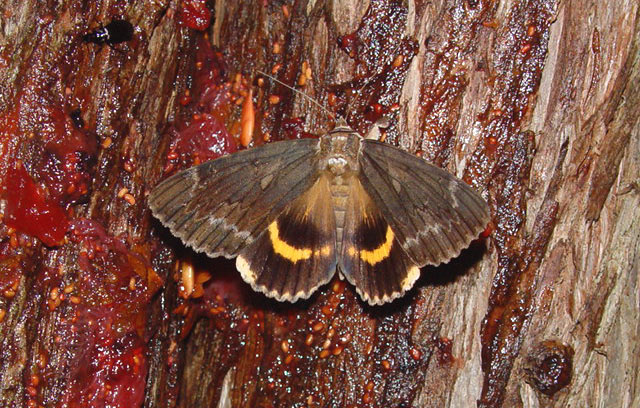
Form "bunkeri" is extremely
rare and lacks the yellow scales in the basal area of the hindwing.
This area is dark brown instead.
Tim Dyson took this shot of "bunkeri" August 10, 2006, in
Peterborough, Ontario.
The forewing is also quite dark, especially
in the median and basal areas, and the hindwing yellow band is reduced in
thickness. | 
|
The species is highly variable with at least
three forms: "bunkeri" Grote, 1876, heavy brown forewing shading,
"eliza" Fischer, 1885, with white forewing patches
"ruperti" Franclemont, 1938, melanic form with deep black-brown
forewing.
There is an aberration, "aurella" with yellow basal hairs on the
hindwing.
Otherwise the black inner and outer bands are very wide and uniform
with brown basal hairs covering the basal area.
All bands are clearly visible on ventral surface.
Catocala cerogama courtesy of Lynn Scott. |

|

Catocala cerogama form "ruperti", from Harold J. Vermes slide,
right side copied to left by Bill Oehlke.
Visit Catocala cerogama in flight, recto and verso, and a number of forms and variations
from Peterborough, Ontario, July 28-August 1, 2016, courtesy of Tim Dyson.
Visit Catocala cerogama verso comparison chart, an excellent
production, showing ventral surface of all three forms of Catocala cerogama, courtesy of Tim Dyson.
FLIGHT TIMES AND PREFERRED FOOD PLANTS:
Catocala cerogama are usually on the wing from
late July to late September in Quebec.When springs and summers are
warm, they begin to appear mid July in southern
Ontario.
Catocala cerogama, July 20, 2005, Peterborough, Ontario,
courtesy of Tim Dyson.
| 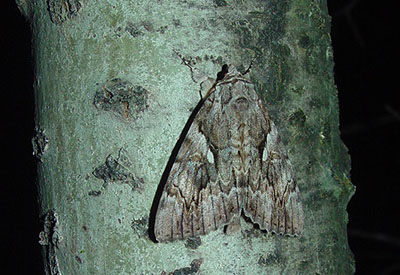 |
Larvae feed on Tilia americana and Tilia glabra.
Adults come to lights and to bait. Moths usually rest high on trees
with head down.
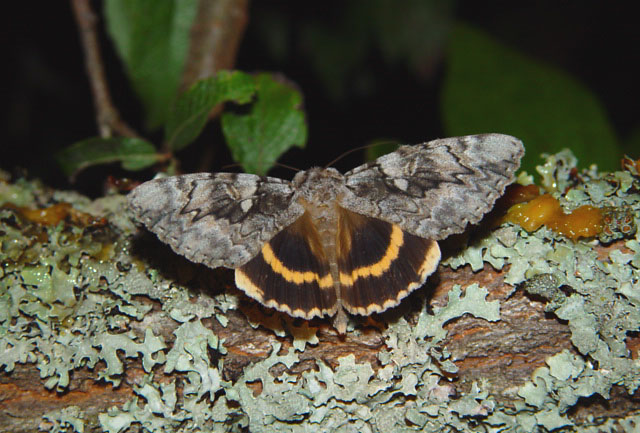
Catocala cerogama, August 17, 2004, Peterborough, Ontario,
courtesy of Tim Dyson copyright.
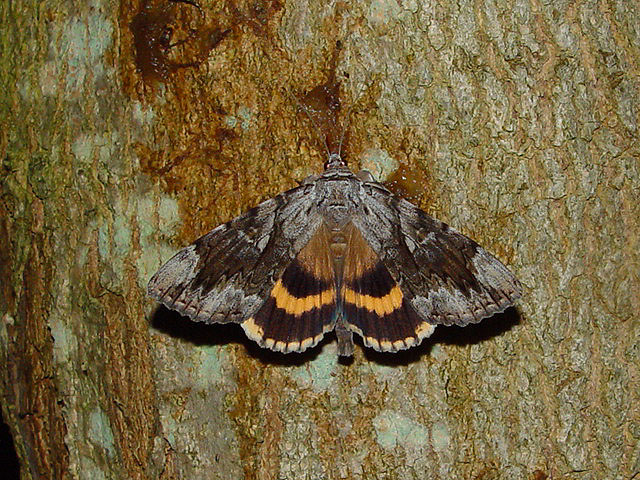
Catocala cerogama, Peterborough, Ontario,
courtesy of Tim Dyson, copyright.
The median area shows varying amounts of dark scaling.
Many thanks also to Vincent Lucas who forwarded the following image to me for identification. The picture was taken by animator/photographer
Meredith Kinrys, in Toronto.
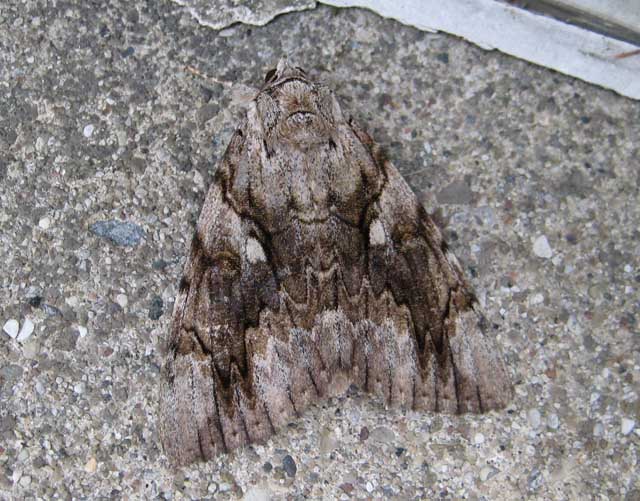
Catocala cerogama, Toronto, Ontario, August 16, 2012,
courtesy of Meredith Kinrys, via Vincent Lucas,
id by Bill Oehlke, based on prominent, pale grey, "arrowhead-shaped", subreniform spot.
ECLOSION:
Adults eclose from pupae at soil surface.
SCENTING AND MATING:
Catocala cerogama females
emit an airbourne pheromone and males use their antennae to track the
scent plume.
EGGS, CATERPILLARS, COCOONS AND PUPAE:Eggs are deposited
on tree bark in the fall and hatch the following spring.
The the larval images to the right and below were
taken and sent to me by Ron Nelson. They are from rearings of Gabriel
Larrabee.
Larvae are being reared on Basswood.
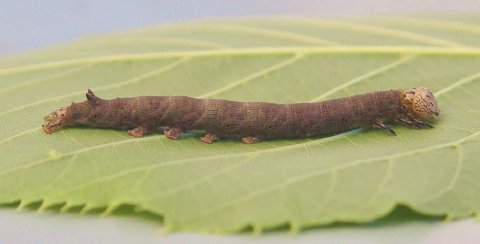
|
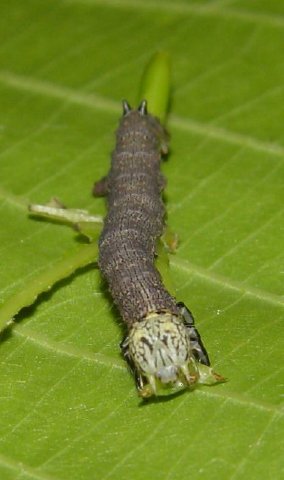 |
Ron Nelson, teamed with Gabriel Larrabee, sent me the images
below of Catocala cerogama
eggs from Milwaukee.

Larval Food Plants
Listed below are primary food plant(s) and alternate food plants.
It is hoped that this alphabetical listing followed by the common
name of the foodplant will prove useful. The list is not exhaustive,
although some species seem very host specific.
Experimenting with closely related foodplants is worthwhile.
Tilia americana.....
Tilia glabra
|
Basswood
American Linden
|
Visit Catocala cerogama Ozaukee County, Wisconsin, July 23, 2010, courtesy of Kate Redmond.
Visit Catocala cerogama, Madison, Dane County, Wisconsin, July 31, 2014, Julie Luther.
Catocala cerogama, Ontario, Canada, July 20, August 17, 25, 2004, courtesy of Tim Dyson.
Visit Catocala cerogama, Sidney, Kennebec County, Maine, August 24, 2011, Steve Lemieux.
Visit Catocala cerogama, Tennessee, August 27, 2008, courtesy of Tom Payne.
Visit Catocala cerogama recto and verso, Mason, Ingham County, Michigan,
August, 1994, courtesy of Harry D. King.
Visit Catocala cerogama, August 27, 2014, Lancaster, Coos Co., Ron White.
Visit Catocala cerogama, Londonderry, Rockingham County, New Hampshire, August 30-September 13, courtesy of Deb Lievens.
Visit Catocala cerogama, Athol, Worcester County, Massachusetts, September 4, 2011, Dave Small
Many thanks also to Paul & Anne Baillargeon who send the following images, also of Catocala cerogama.
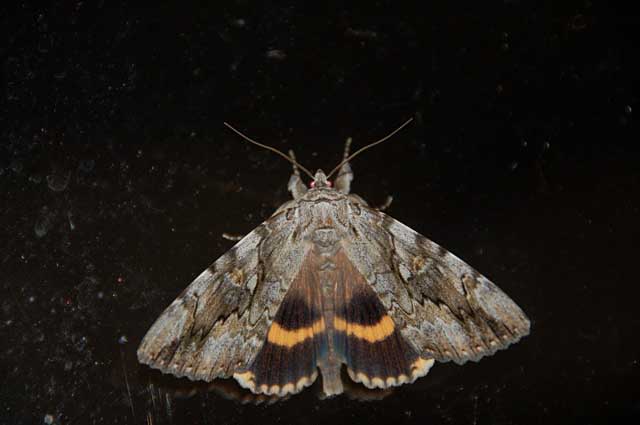
Catocala cerogama, Canoe Lake, Frontenac County, Ontario,
August 2, 2015, courtesy of Paul & Anne Baillargeon.

Catocala cerogama, Canoe Lake, Frontenac County, Ontario,
August 2, 2015, courtesy of Paul & Anne Baillargeon.
This page is brought to you by Bill Oehlke and the
WLSS. Pages are on space rented from Bizland. If you would like to become a "Patron of the Sphingidae or Catocala Sites", contact Bill.
Please send sightings/images to Bill. I will do my best to respond to requests for identification help.
Enjoy one of nature's wonderments: Live Saturniidae (Giant Silkmoth) cocoons.

|

Click on the flashing butterfly to show
appreciation for this site
and to visit other insect related
sites. |
Return to Canadian Index
Return to Main Index















